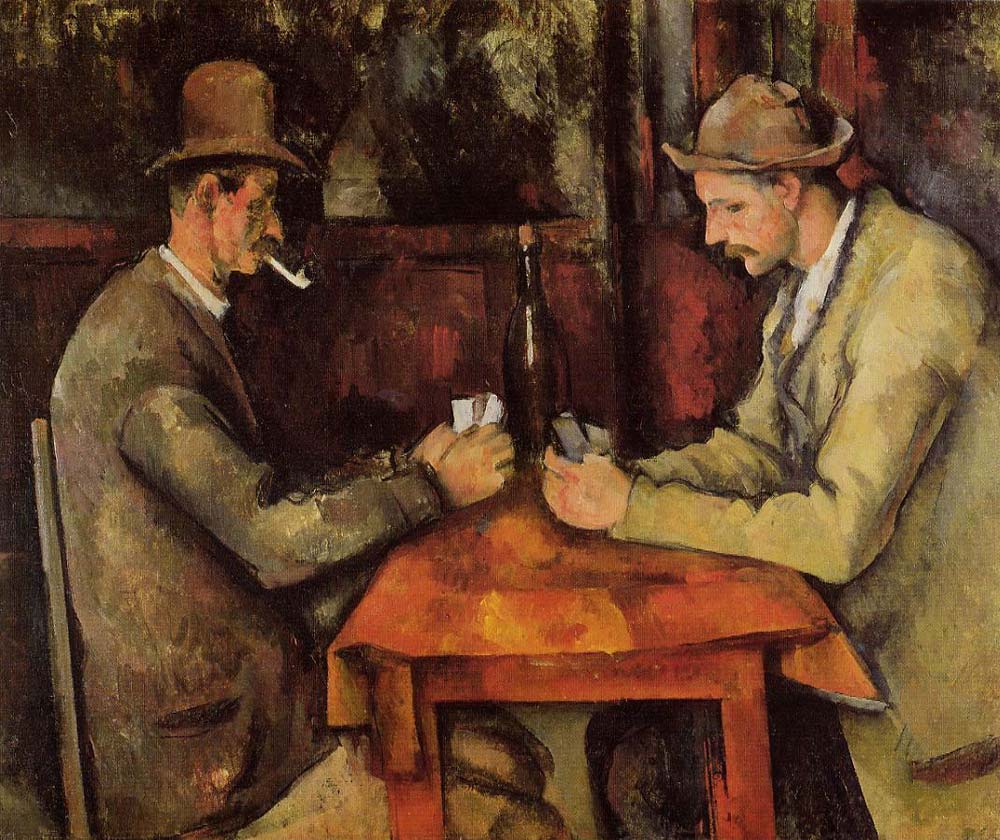| The Card Players | |
|---|---|
 |
|
| Artist | Paul Cézanne |
| Year | 1894–1895 |
| Medium | Oil on canvas |
| Location | Musée d’Orsay, Paris |
| Famous Paintings by Cézanne | |
| Pyramid of Skulls | |
| The Bathers | |
| The Card Players | |
| The Basket of Apples | |
| Rideau, Cruchon et Compotier | |
| A Modern Olympia | |
| Complete Works |
The Card Players is a famous oil painting by Paul Cezanne, who was a renowned post-impressionist French artist. He painted this remarkable artwork during his final period, which was in the early 1890s. Cezanne created a variety of sizes and versions of the painting, as presented in the number of players present in the artwork. Furthermore, he completed several sketches and analysis as he prepared for the different series of The Card Players. One of the versions of The Card Players was priced at around $250 million to $300 million, and it was sold in 2011. Hence, it was considered as the most expensive artwork that was ever sold.
Artwork Analysis
The series of this impressive artwork was said to be the finest among Cezanne’s works during the 1890s, and it also served as the highlight to the artist’s final years. Each painting by Cezanne depicts typical Provencal peasants that were immersed in their mundane activities as they smoked their pipes and played cards. The subjects of the painting are all male, and they appear to be intently focused on their game at hand.
The artist adapted a theme from the Dutch and French genres of painting of the 17th century, which presented card games played by drunken and rowdy gamblers in taverns. However, Cezanne replaced these figures with stone-faced and serious tradesmen in a rather simplified setting. While most paintings during that era were quite emotional, Cezanne’s artworks were known for their lack of emotions, conventional characterization and narration. Moreover, there are no signs of drama or sentiments, which were prominent images of 17th century paintings.
About Cezanne and His Artworks
Most of the models for Cezanne’s paintings were farm hands, and several of them worked on the artist’s family estate. Each of the scenes in his paintings is presented as still and quiet, and the card players appeared to be focused on their game. This image seemed to present how the cards serve as the men’s sole means of communication after their work. In fact, most critics describe the scenes as the representation of the human still life, while others believe that the men’s focus on the game depicted the artist’s absorption in his artworks.
Cezanne created quite a number of sketches and studies as he prepared for The Card Players series. He made more than a dozen preparatory drawings, and he painted several local farm workers to discover the best image that will suit his final paintings. Some critics also believed that most of Cezanne’s models sat for studies instead of the actual works, and that the artist completed his preliminary work in the Aix Cafe.
The Card Players by Paul Cezanne was not entirely a portrait of two men intently focused on their game. In fact, this magnificent artwork was more of an exploration and discovery of the possible nuance of color and volume. The radiant white highlight in the painting seems to divide the composition into two sections, and this calls attention to the dark and light tonalities of the men’s dresses. With these impressive details and features, The Card Players was known as one of the most brilliant artworks of all time.